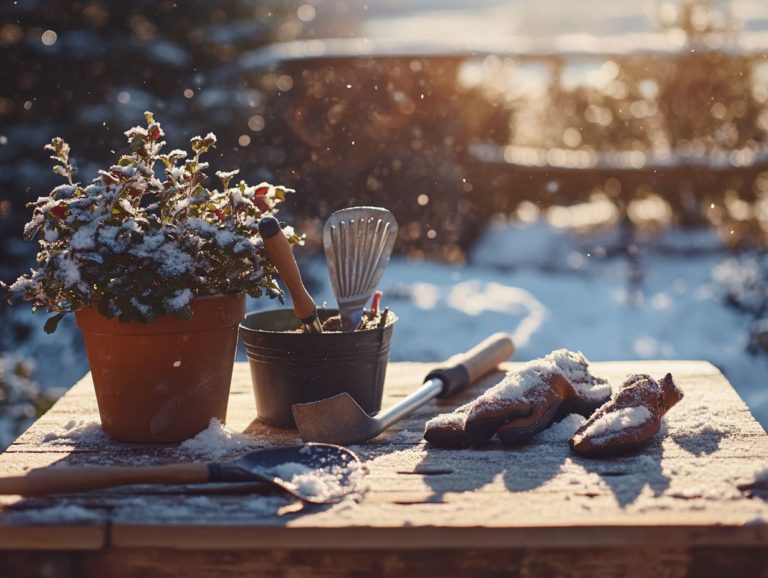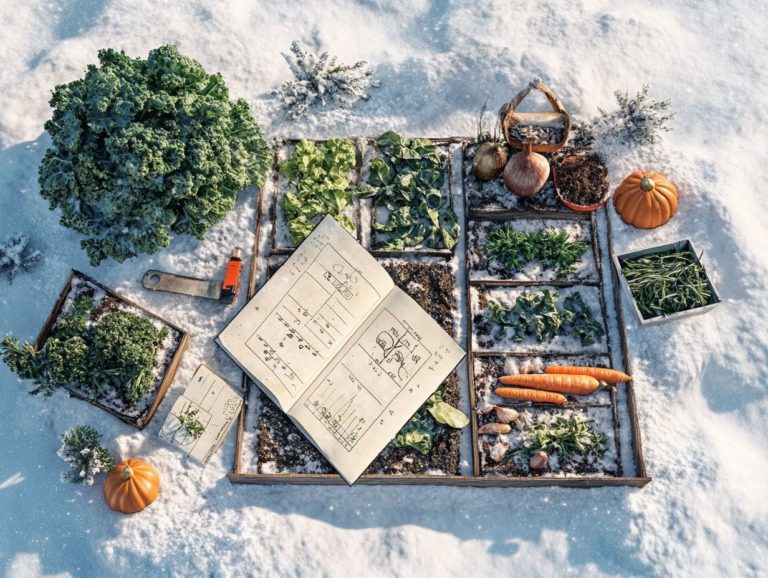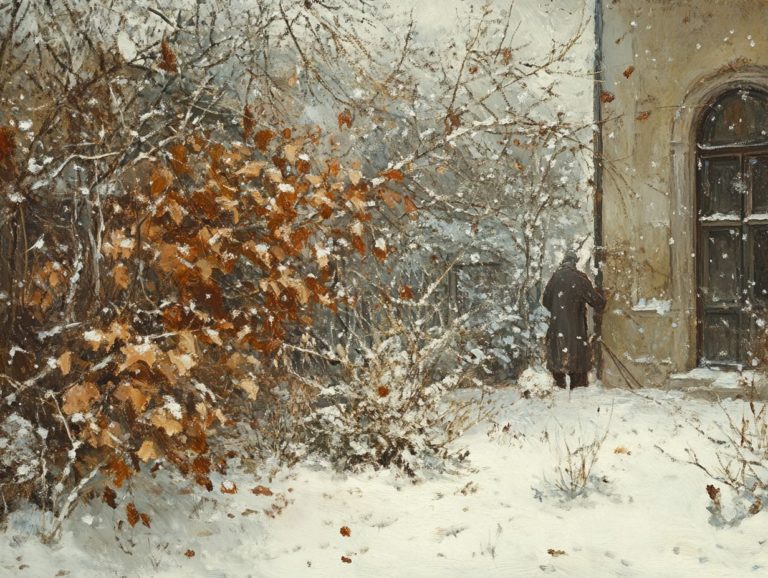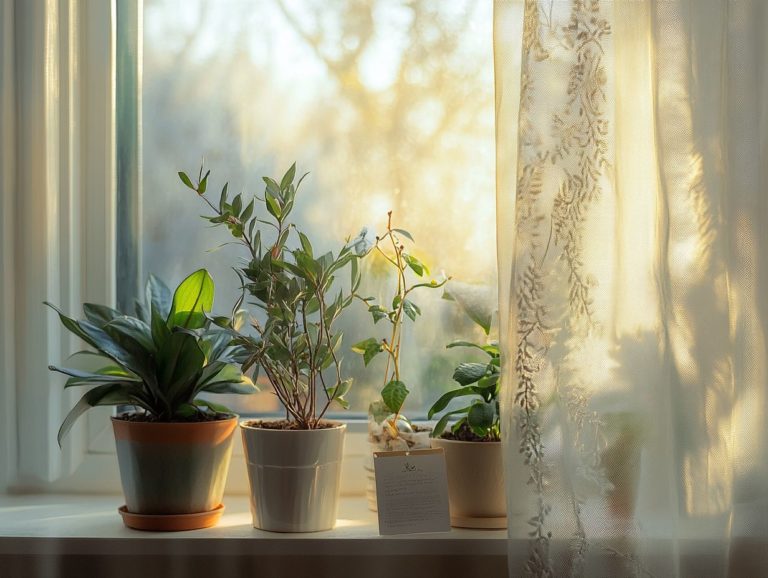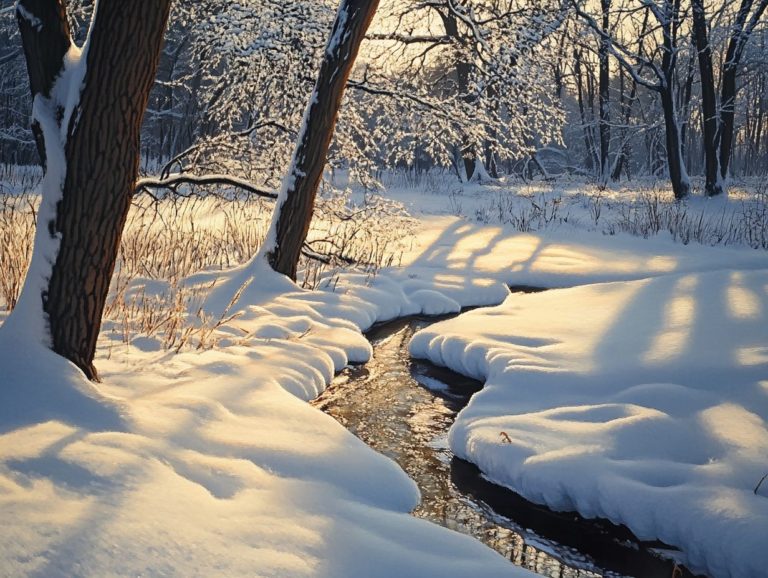Top 5 Winter Gardening Mistakes to Avoid
Winter gardening can be a truly rewarding pursuit, though it comes with its unique challenges. You may find that many gardeners inadvertently stumble into mistakes that can stifle their plants growth or even lead to outright failure. From inadequate soil preparation to miscalculating the timing of planting, these pitfalls are easily sidestepped with a touch of knowledge.
This article delves into the top five winter gardening mistakes you should avoid, offering valuable tips to elevate your winter gardening experience. You’ll discover the best plants to cultivate, how to ready your garden for the frosty months ahead, and effective strategies for shielding your plants from winter pests.
Embrace the season and get ready to cultivate a vibrant garden that thrives even in winter!
Contents
- Key Takeaways:
- 1. Not Preparing the Soil Properly
- 2. Planting Too Early or Too Late
- 3. Overwatering or Underwatering Plants
- 4. Not Protecting Plants from Frost and Cold Temperatures
- 5. Not Adjusting Fertilizer and Nutrient Levels
- What Are the Best Plants to Grow in Winter?
- Frequently Asked Questions
- What are the top 5 winter gardening mistakes?
- How can I protect my plants from cold temperatures during winter?
- Why is it important to provide enough water to plants during winter?
- What are some common mistakes people make when mulching in winter?
- How can I properly prune my plants in winter?
- Why is it important to plan ahead for spring during the winter?
Key Takeaways:
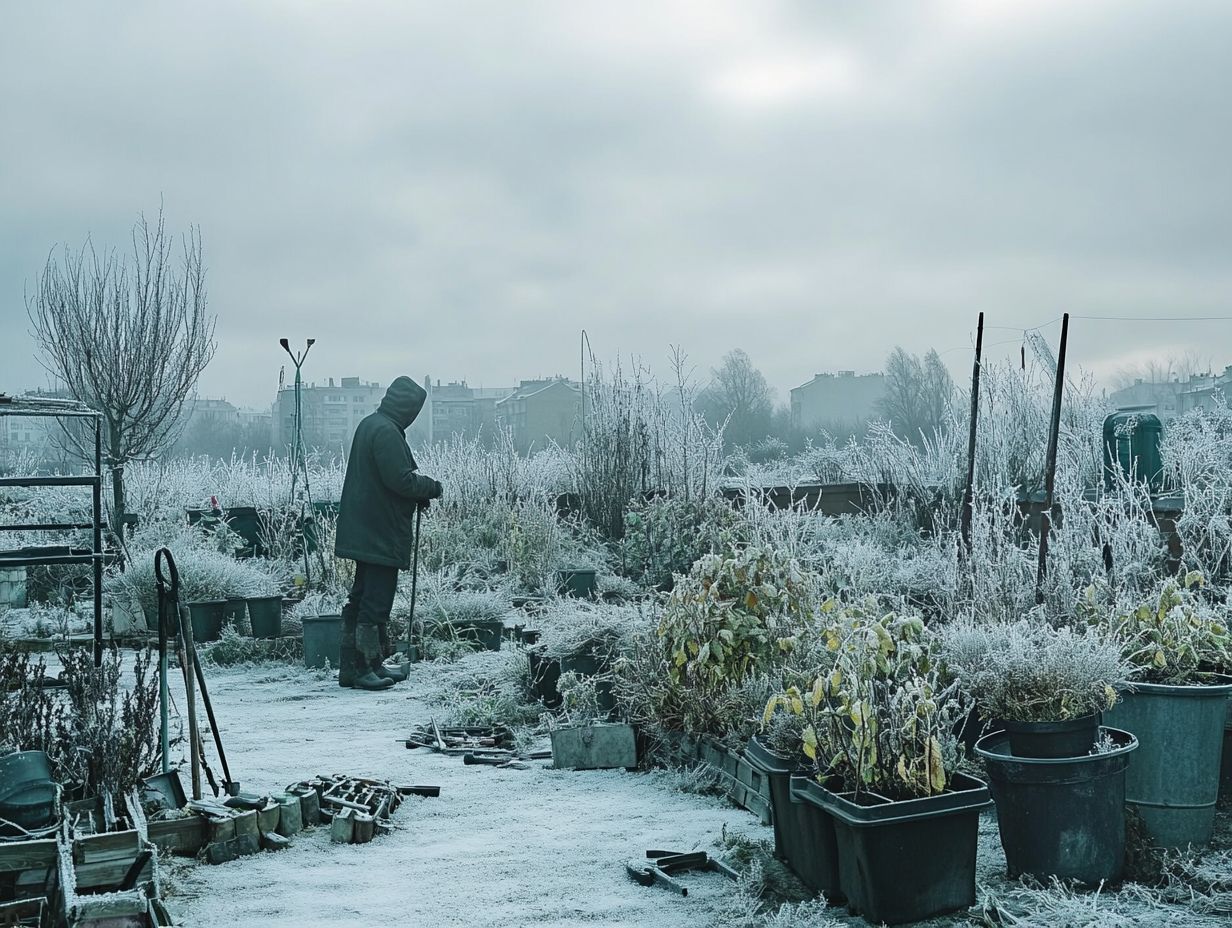
- Don’t neglect soil preparation; it’s crucial for healthy winter plants.
- Plant at the right time; avoid starting too early or too late in the season.
- Properly water plants; too much or too little can be detrimental to their growth.
1. Not Preparing the Soil Properly
Proper soil preparation is essential for successful winter gardening. It directly influences the health, growth, and overall biodiversity of your outdoor sanctuary during the colder months. Many gardeners underestimate the significance of improving the soil, often overlooking crucial factors like moisture and nutrient levels. This can lead to common pitfalls that undermine their winter care routines.
As gardening expert Helen Nyul frequently emphasizes, incorporating compost can greatly enhance your soil, ensuring that all plant varieties, from dahlias to pelargoniums, flourish even in the chill.
Along with adding compost, consider employing techniques such as tilling and mulching to aerate the soil and maintain temperature stability. Well-prepared soil improves water retention, minimizing the need for frequent watering and protecting plant roots from frost damage. It’s crucial to avoid over-compaction during preparation, as this can create barriers for roots and hinder their growth.
Investing time in soil health offers long-term benefits, promoting sustainable gardening practices and cultivating a vibrant ecosystem that supports both your plants and local wildlife.
2. Planting Too Early or Too Late
Timing is everything when it comes to planting during the winter months. Planting at the right time is vital for the success of your garden, especially considering the varying areas that indicate how well plants can survive winter across the UK.
Understanding the right window for different plant varieties is crucial. For instance, leafy greens like kale and spinach thrive in colder conditions and can be sown in the fall for a delightful winter harvest. It’s important to assess environmental conditions, including temperature fluctuations and soil moisture, to pinpoint the best planting times. By referencing local hardiness zones, you can make informed decisions, ensuring your selections are perfectly suited for winter growth.
The advantages of fall planting are considerable. Not only does it allow for stronger root establishment, but with meticulous garden planning, you can cultivate a robust garden that yields quality produce even in the chillier months.
3. Overwatering or Underwatering Plants
Managing soil moisture levels in winter gardening is an art form; a delicate balance where overwatering or underwatering can create significant challenges, like root rot or plant dehydration. Investing in proper irrigation systems can help maintain optimal moisture levels, ensuring your garden thrives even in the cold seasons.
Understanding the impact of moisture on plant health is essential, especially as temperatures dip. In winter, the reduced evaporation means moisture tends to linger longer in the soil, making it crucial to monitor those levels regularly.
Tools like drip irrigation and soaker hoses are your best friends for providing a controlled water supply, minimizing the risk of water pooling around the roots. To avoid common pitfalls, make it a habit to check moisture levels by sticking a finger or a moisture meter into the ground, then adjust your watering schedule based on those readings.
It s wise to consider the specific needs of your plants, as some may prefer less water during their dormancy.
4. Not Protecting Plants from Frost and Cold Temperatures
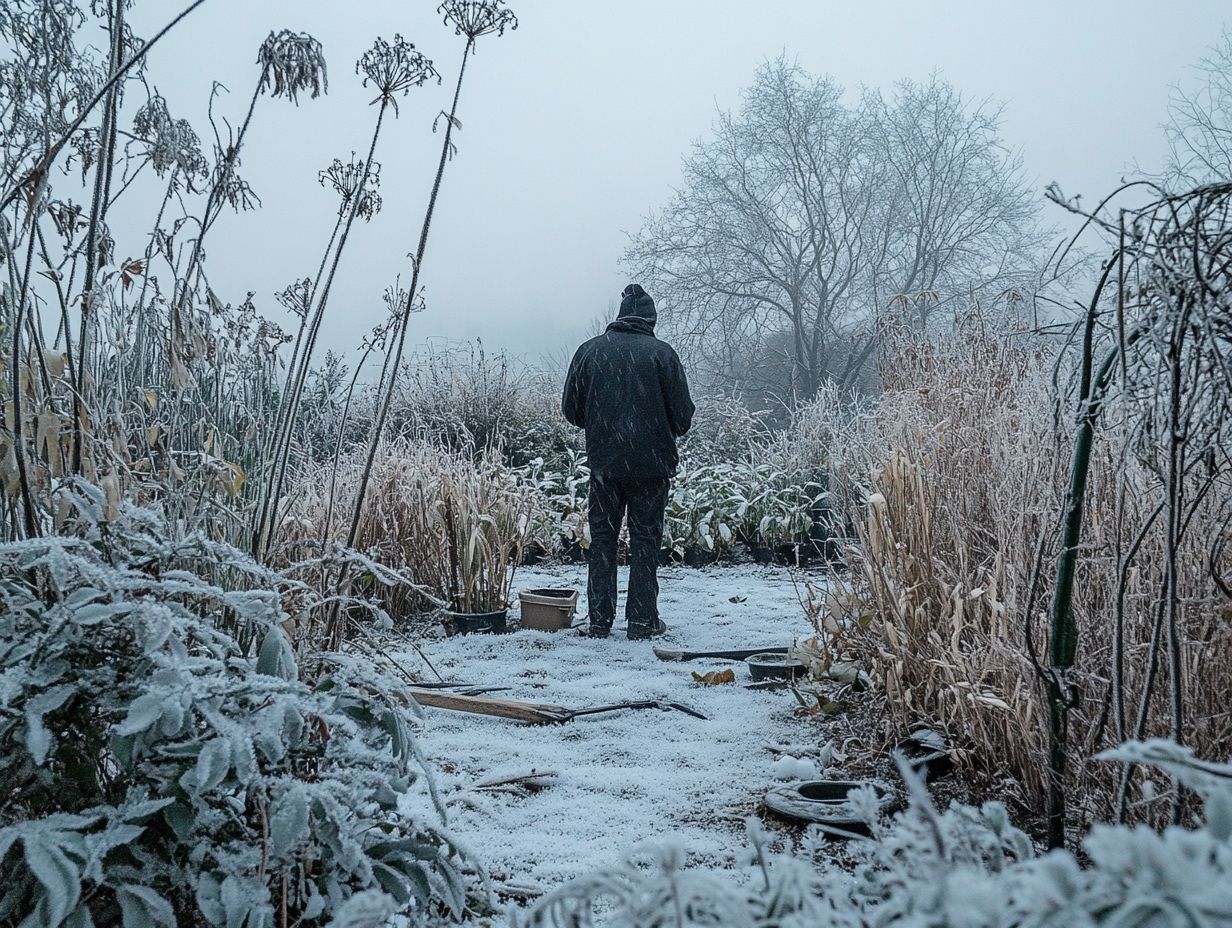
Frost protection is crucial for ensuring that your sensitive plants survive the winter. Without proper shielding from cold temperatures, they risk damage or even death especially varieties like Arctic King and Winter Marvel. To safeguard your plants, you must utilize adequate coverings and other protective measures that create a warm environment that helps plants thrive amidst harsh conditions.
Use specialized plant covers, such as frost cloths or burlap, which trap warmth and protect delicate foliage. You can also use organic materials like straw or mulch around the plant bases to enhance protection. Consider moving potted plants to more sheltered locations or wrapping their containers in insulating materials; these methods significantly increase their chances of survival.
Timeliness is essential. For instance, winter flowering plants like pansies and violas need your attention as early as late fall.
Make sure to water your plants before the cold hits to maintain cellular hydration. By implementing these practical winter care strategies, you can ensure that your plants not only survive but thrive in challenging weather conditions.
5. Not Adjusting Fertilizer and Nutrient Levels
Neglecting to adjust fertilizer and nutrient levels during winter can compromise your plants’ nutrition, ultimately impacting their growth and health in the colder months. Understanding the specific nutritional needs of your plants during this season is essential for maintaining a thriving garden.
As temperatures dip, the activity of soil microorganisms slows down considerably, affecting nutrient availability. This change calls for a thoughtful reevaluation of your fertilization strategies, focusing on supplementing the soil with essential micronutrients that are often overlooked.
One common mistake is applying fertilizers that are too high in nitrogen, which can lead to nutrient runoff and potentially harm your plant roots in the cold. To sidestep these issues, conduct regular soil testing. This will allow you to tailor your nutrient management effectively. By analyzing soil composition, you can optimize your fertilization practices, ensuring your plants receive the precise nutrients they need to thrive through winter.
What Are the Best Plants to Grow in Winter?
Choosing the best plants for winter gardening can elevate biodiversity and transform your outdoor space into a captivating sanctuary. Picture hardy vegetables, vibrant flowers, and decorative plants that not only survive but thrive during the colder months, even when nestled in a cold frame.
While many might dismiss gardening as a warm-weather pursuit, a diverse array of resilient plants proves otherwise, offering both nourishment and bursts of color to your winter landscape. Take kale and spinach, for instance; these greens can provide fresh produce even as temperatures drop. By incorporating colorful ornamental cabbages and pansies, you’ll enhance the visual appeal of your garden and support local wildlife during the leaner months.
To ensure your winter garden flourishes, consider implementing strategies like mulching, shielding roots with protective covers, and ensuring adequate drainage. This way, you can enjoy a vibrant and thriving garden that remains healthy throughout the frosty season.
Start protecting your plants now and explore the joys of winter gardening!
How Can One Prepare Their Garden for Winter?
Preparing your garden for winter is an art that involves a series of essential tasks designed to ensure the health and vitality of your plants. Think of it as a winter spa treatment for your garden, encompassing everything from pruning to applying a protective layer of mulch. These tasks are crucial for safeguarding your plants from freezing temperatures and creating an inviting environment for vibrant growth when spring arrives.
Start by meticulously pruning away any dead or damaged branches. This encourages healthy regrowth and keeps your garden vigorous, ready to burst back to life when warmer weather returns. Next, don t underestimate the power of a proper layer of mulch. It acts like a cozy blanket, conserving soil moisture and regulating temperature fluctuations.
To prepare your garden, clear away debris, amend the soil if necessary, and plant cover crops to enrich the soil during winter. Each of these steps builds a robust garden ecosystem, positioning your plants to thrive when those glorious warmer days finally re-emerge.
What Are the Benefits of Winter Gardening?
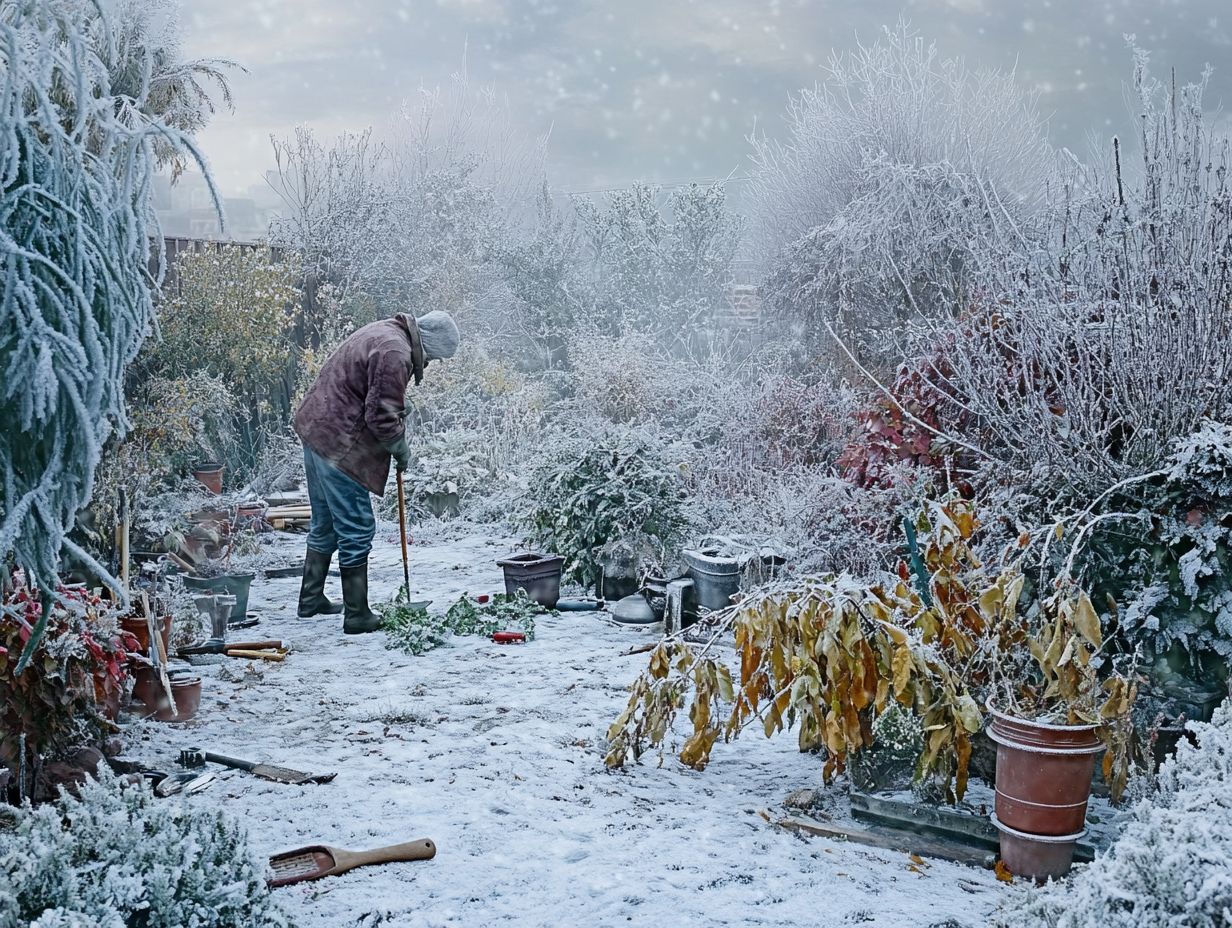
Winter gardening offers a wealth of benefits that enhance your garden’s health, promote sustainability, and support wildlife during the colder months. It allows you to stay connected with your outdoor space, even as temperatures drop.
You can implement techniques such as planting winter cover crops. These plants enrich your soil, prevent erosion, and serve as a habitat for beneficial insects, helping maintain the ecological balance. By integrating native plants into your winter garden, you beautify your landscape while attracting local pollinators and birds in need of refuge and sustenance.
Practicing mulching helps regulate soil temperature, preserve moisture, and offer shelter to small creatures. By cultivating a winter garden, you dramatically boost biodiversity, transforming your yard into a sanctuary that fosters a healthier ecosystem. All the while, you can relish the serene beauty of nature, even in the coldest months.
How Can One Protect Plants from Winter Pests?
Protecting your plants from winter pests is essential for maintaining your garden’s health. Many gardeners underestimate the threats that lurk during the colder months.
Even when plants go dormant, pesky insects can still cause significant damage. It s crucial to adopt effective pest management strategies. By implementing preventative measures like properly storing your garden tools and clearing away debris where pests might find refuge you can decrease the chances of infestations.
Embrace organic methods, such as introducing beneficial insects or using natural repellents. These strategies help in managing pest populations and align with a more eco-friendly gardening philosophy.
Don’t overlook indoor plants or forget to check for pests before bringing them inside. Learn to identify early signs of infestation, like unusual leaf damage or droppings. This allows you to take timely action and ensure your plants thrive.
What Are Some Common Winter Gardening Tools and Supplies?
Having the right gardening tools and supplies for winter gardening is crucial for effective maintenance. This preparation allows you to tackle tasks such as composting, mowing the lawn, and managing weeds, all in anticipation of the vibrant spring ahead.
Investing in quality tools elevates your gardening experience and ensures that every chore is completed with efficiency and ease. For instance, a sturdy compost bin efficiently breaks down organic matter, enriching your soil for future planting. Protective gear, like frost cloths and mulch, helps retain soil warmth and shields your tender plants from winter chill. A reliable snow shovel is essential for keeping pathways clear and protecting your perennials from damage.
By arming yourself with these essential items, you can maintain a vibrant garden that s ready to burst back to life when spring arrives. Get started today and watch your garden flourish this spring!
How Can One Extend the Growing Season in Winter?
You can extend your growing season in winter. Use techniques like cold frames, companion planting, and optimizing your garden for seasonal changes.
You can shield your crops by strategically using these methods. Cold frames act like mini-greenhouses, trapping heat and creating a cozy environment for your more sensitive plants.
Companion planting, where compatible plants support each other, can enhance your garden’s resilience against pests and diseases. This ensures a more plentiful harvest despite the chill.
To maximize your limited garden space during winter, consider vertical gardening techniques and intercropping. These approaches allow multiple crops to flourish in the same area, boosting yield while minimizing risk.
Frequently Asked Questions

What are the top 5 winter gardening mistakes?
The top 5 winter gardening mistakes to avoid are:
- Not protecting plants from cold temperatures
- Not providing enough water
- Not mulching properly
- Not pruning correctly
- Not planning ahead for spring
How can I protect my plants from cold temperatures during winter?
To protect your plants from cold temperatures during winter, cover them with blankets or cloths. You can also use frost covers and add a layer of mulch around the base of the plants. Moving potted plants indoors or into a greenhouse is also effective.
Why is it important to provide enough water to plants during winter?
During winter, plants still need water to survive, but they may not receive enough from natural rainfall. Providing enough water prevents them from drying out and becoming damaged.
What are some common mistakes people make when mulching in winter?
Common mistakes when mulching in winter include:
- Using too much mulch
- Placing it too close to the base of the plant
- Using the wrong type of mulch
These can lead to suffocation of the plant, root rot, and attracting pests.
How can I properly prune my plants in winter?
When pruning in winter, use sharp and clean tools to avoid damaging the plant. Remove any dead or diseased branches, and only prune lightly to avoid stimulating new growth that can be damaged by frost.
Why is it important to plan ahead for spring during the winter?
Winter is the perfect time to plan for your spring garden. This includes ordering seeds, preparing the soil, and creating a planting schedule. By planning ahead, you can ensure a successful and beautiful spring garden.
Don’t wait! Start planning for your spring garden now to ensure a beautiful and bountiful harvest!

